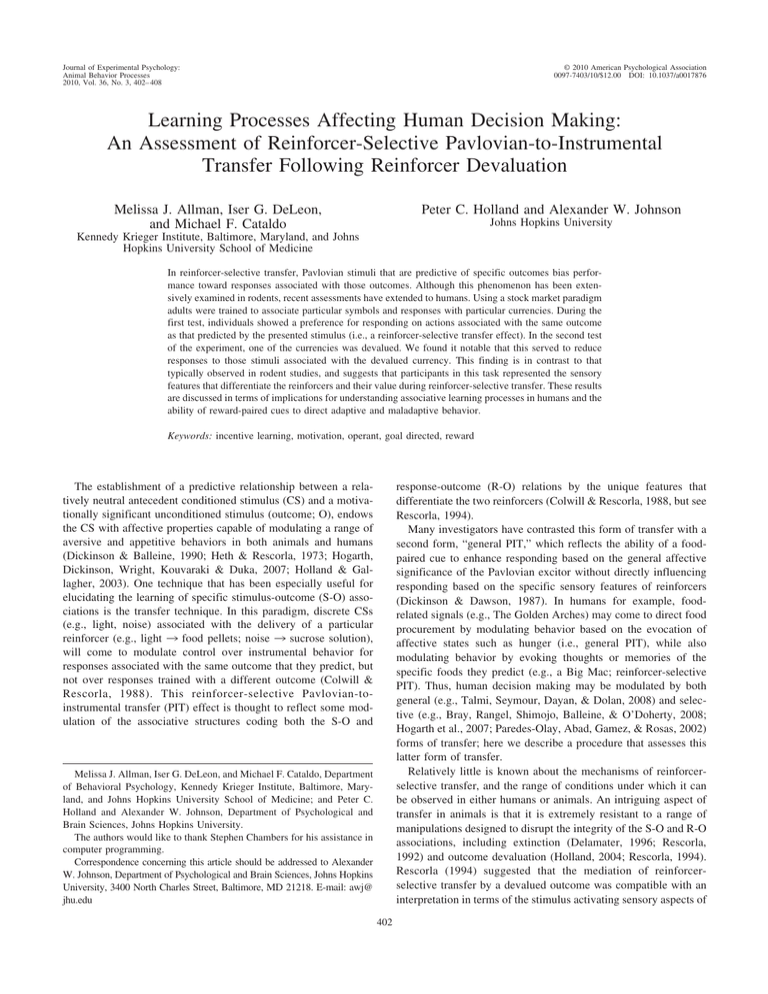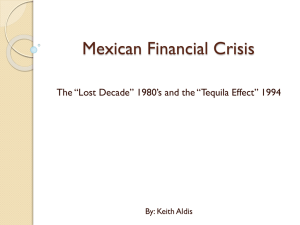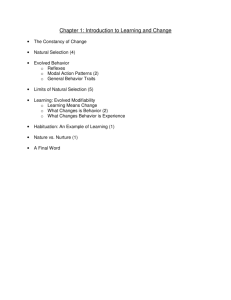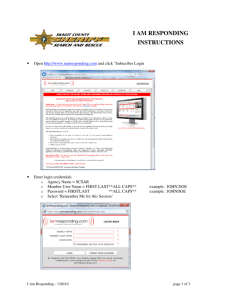Learning Processes Affecting Human Decision Making: An Assessment of Reinforcer-Selective Pavlovian-to-Instrumental
advertisement

Journal of Experimental Psychology: Animal Behavior Processes 2010, Vol. 36, No. 3, 402– 408 © 2010 American Psychological Association 0097-7403/10/$12.00 DOI: 10.1037/a0017876 Learning Processes Affecting Human Decision Making: An Assessment of Reinforcer-Selective Pavlovian-to-Instrumental Transfer Following Reinforcer Devaluation Melissa J. Allman, Iser G. DeLeon, and Michael F. Cataldo Peter C. Holland and Alexander W. Johnson Johns Hopkins University Kennedy Krieger Institute, Baltimore, Maryland, and Johns Hopkins University School of Medicine In reinforcer-selective transfer, Pavlovian stimuli that are predictive of specific outcomes bias performance toward responses associated with those outcomes. Although this phenomenon has been extensively examined in rodents, recent assessments have extended to humans. Using a stock market paradigm adults were trained to associate particular symbols and responses with particular currencies. During the first test, individuals showed a preference for responding on actions associated with the same outcome as that predicted by the presented stimulus (i.e., a reinforcer-selective transfer effect). In the second test of the experiment, one of the currencies was devalued. We found it notable that this served to reduce responses to those stimuli associated with the devalued currency. This finding is in contrast to that typically observed in rodent studies, and suggests that participants in this task represented the sensory features that differentiate the reinforcers and their value during reinforcer-selective transfer. These results are discussed in terms of implications for understanding associative learning processes in humans and the ability of reward-paired cues to direct adaptive and maladaptive behavior. Keywords: incentive learning, motivation, operant, goal directed, reward response-outcome (R-O) relations by the unique features that differentiate the two reinforcers (Colwill & Rescorla, 1988, but see Rescorla, 1994). Many investigators have contrasted this form of transfer with a second form, “general PIT,” which reflects the ability of a foodpaired cue to enhance responding based on the general affective significance of the Pavlovian excitor without directly influencing responding based on the specific sensory features of reinforcers (Dickinson & Dawson, 1987). In humans for example, foodrelated signals (e.g., The Golden Arches) may come to direct food procurement by modulating behavior based on the evocation of affective states such as hunger (i.e., general PIT), while also modulating behavior by evoking thoughts or memories of the specific foods they predict (e.g., a Big Mac; reinforcer-selective PIT). Thus, human decision making may be modulated by both general (e.g., Talmi, Seymour, Dayan, & Dolan, 2008) and selective (e.g., Bray, Rangel, Shimojo, Balleine, & O’Doherty, 2008; Hogarth et al., 2007; Paredes-Olay, Abad, Gamez, & Rosas, 2002) forms of transfer; here we describe a procedure that assesses this latter form of transfer. Relatively little is known about the mechanisms of reinforcerselective transfer, and the range of conditions under which it can be observed in either humans or animals. An intriguing aspect of transfer in animals is that it is extremely resistant to a range of manipulations designed to disrupt the integrity of the S-O and R-O associations, including extinction (Delamater, 1996; Rescorla, 1992) and outcome devaluation (Holland, 2004; Rescorla, 1994). Rescorla (1994) suggested that the mediation of reinforcerselective transfer by a devalued outcome was compatible with an interpretation in terms of the stimulus activating sensory aspects of The establishment of a predictive relationship between a relatively neutral antecedent conditioned stimulus (CS) and a motivationally significant unconditioned stimulus (outcome; O), endows the CS with affective properties capable of modulating a range of aversive and appetitive behaviors in both animals and humans (Dickinson & Balleine, 1990; Heth & Rescorla, 1973; Hogarth, Dickinson, Wright, Kouvaraki & Duka, 2007; Holland & Gallagher, 2003). One technique that has been especially useful for elucidating the learning of specific stimulus-outcome (S-O) associations is the transfer technique. In this paradigm, discrete CSs (e.g., light, noise) associated with the delivery of a particular reinforcer (e.g., light 3 food pellets; noise 3 sucrose solution), will come to modulate control over instrumental behavior for responses associated with the same outcome that they predict, but not over responses trained with a different outcome (Colwill & Rescorla, 1988). This reinforcer-selective Pavlovian-toinstrumental transfer (PIT) effect is thought to reflect some modulation of the associative structures coding both the S-O and Melissa J. Allman, Iser G. DeLeon, and Michael F. Cataldo, Department of Behavioral Psychology, Kennedy Krieger Institute, Baltimore, Maryland, and Johns Hopkins University School of Medicine; and Peter C. Holland and Alexander W. Johnson, Department of Psychological and Brain Sciences, Johns Hopkins University. The authors would like to thank Stephen Chambers for his assistance in computer programming. Correspondence concerning this article should be addressed to Alexander W. Johnson, Department of Psychological and Brain Sciences, Johns Hopkins University, 3400 North Charles Street, Baltimore, MD 21218. E-mail: awj@ jhu.edu 402 LEARNING PROCESSES AFFECTING HUMAN DECISION MAKING an outcome representation, which in turn activates the response (i.e., outcome-response [O-R] associations). According to this view, with S-O and O-R associations, the ability of S to elicit R is mediated by sensory aspects of O (e.g., Trapold & Overmier, 1972). This signaling role for the CS, rather than a motivational one, is consistent with the lack of impact of outcome devaluation (Holland, 2004; Rescorla, 1994). In the current experiment we implemented a reinforcer-selective transfer procedure for use in humans, which also permitted assessing the effects of reinforcer devaluation on that transfer. Participants were informed they were to play the role of an investment banker for a Fortune 500 company in a “stock market” paradigm. First, Pavlovian stimuli (companies) were paired with outcomes (the currency in which the company traded). Second, participants made different key-press responses for presentations of the different outcomes (currencies). In the test phase, the stimuli were again presented and participants were free to respond at will. Reinforcerselective transfer would be evidenced by the capacity of each stimulus to augment key-press responses previously associated with the same currency. A second test phase was administered after a manipulation designed to devalue one of the outcomes: Participants were told that one of the currencies had lost value due to a stock market crash. We were particularly interested in the extent to which this selective outcome devaluation treatment affected transfer during the second test. Method Participants, Materials, and Stimuli Nineteen adult participants, four men and 12 women, aged 19 to 54 years (M ⫽ 29 years; SD ⫽ 7.2) completed the study. All participants were recruited from flyers posted around the Kennedy Krieger Institute, Baltimore, Maryland and Johns Hopkins Institutions. The study was approved by the Johns Hopkins Medical Institutional Review Board and all participants provided written consent. During the recruitment and consent processes participants were told they would be able to exchange any monies earned during the course of the experiment into U.S. dollars, and that during the experiment they would be earning money in two currencies (from Mexico [MX] or Hong Kong [HK]). A PC running a custom written program in Microsoft Visual Basic 2005 was used to present the visual stimuli, and responses on a computer keyboard were recorded. Eight 48-pt Ariel font black ASCII character stimuli (e.g., §, Ð, ⫽) centered on a white background were used as the Pavlovian stimuli, and the outcomes were of a similar format (⫹HK$1; ⫹MX$1; or no outcome —). Three stimuli were paired with the HK currency (⫹HK$1), three were paired with the MX currency (⫹MX$1) and two stimuli were unrewarded (—). The arrangement of stimuli and outcome contingencies were counterbalanced between participants. During both the Pavlovian and instrumental training phases, to determine that participants were paying attention and looking at the delivery of the rewarded outcomes (i.e., ⫹HK$1 or ⫹MX$1) they were required to press the spacebar within 2 s of the onset of the outcome screen to “bank” the money. Participants were told that if they did not press the spacebar as soon as they saw the money on the screen they would not bank the money. Pressing the spacebar advanced the program onto the next trial. Any failure to press the spacebar 403 within the time frame caused the last trial to repeat, and participants were informed that they “need to be quicker” when banking the money. During the instrumental and test phases, assigned response keys were 1, 5, and 9 and throughout the procedure each had a “sticky dot” attached to identify it as a target key. The identity of keys (1, 5, & 9) was counterbalanced with respect to the consequent outcome (⫹HK$1; ⫹MX$1; or —). Procedures A summary of the experimental procedure is depicted in Table 1. Prior to the start of experimental testing, participants read the following vignette presented on a computer screen, which was also read out by the experimenter: You have been employed as a stockbroker by a Fortune 500 company. Soon you’ll be presented with a series of symbols that are each individual companies. Certain companies trade in either Mexican or Hong Kong money. You need to try and figure out which company (symbol) “goes with” which currency. Later on you will be able to earn money for these companies, which is your job. You need to try and make as much money as possible. At the end of the study, you will be able to exchange any money you have made for the companies for American dollars that you can keep. You need to have 9 Mexican $ before you can swap them for U.S. $1. You need to have 9 Hong Kong $ before you can swap them for U.S. $1. That is, both the currencies are worth the same in terms of U.S. dollars at this time. Following this, participants were asked to rate on a visual scale whether they had any underlying (confounding) preference for either of the two currencies (strongly prefer, prefer, no preference). Stage 1: Pavlovian conditioning. This stage was introduced by the following instructions presented on the computer, and read aloud by the experimenter: In this part of the study, you will see symbols on the computer screen. Each symbol is a company. You need to pay attention to these as they will be followed by some money in the currency that the company trades in (either MX$1 or HK$1). You need to press the spacebar as soon as you see the money on the screen to bank it. Once the participant demonstrated that they understood the requirements of the task, one block of 160 trials began (20 trials with each stimulus). The stimuli were presented in a pseudorandom sequence assigned by the computer, with the constraint that no more than two trials of the same stimulus could occur in succession, and no more than four trials of each outcome type could occur in succession. Each stimulus was presented on the screen for 4 s, and following an interval of 0.5 s, the outcome (either ⫹HK$1; ⫹MX$1; or —) was presented on the screen for 2 s. The intertrial interval (ITI) ranged between 1 and 3 s (M 2 s). Participants did not receive a running tally of the number of each of the respective outcomes they had earned during this phase. Stage 2: Instrumental conditioning. This stage was preceded with the following instructions: In this next part of the study, you need to press some buttons on the computer keyboard in order to get the money. You can only press buttons 1, 5, and 9 on the number pad, and sometimes you will get money and ⬁: Key 1 ⬎ Key 2 : Key 1 ⬎ Key 2 : Key 1 ⬎ Key 2 §: Key 2 ⬎ Key 1 Ð: Key 2 ⬎ Key 1 ⫽: Key 2 ⬎ Key 1 ⍀ 3 Key 1 ⫽ Key 2 3 Key 1 ⫽ Key 2 ⫹HK$ 3 Stock market crash ⬁: Key 1 ⬎ Key 2 : Key 1 ⬎ Key 2 : Key 1 ⬎ Key 2 §: Key 2 ⬎ Key 1 Ð: Key 2 ⬎ Key 1 ⫽: Key 2 ⬎ Key 1 ⍀ 3 Key 1 ⫽ Key 2 3 Key 1 ⫽ Key 2 ⬁ 3 ⫹MX$1 3 ⫹MX$1 3 ⫹MX$1 § 3 ⫹HK$1 Ð 3 ⫹HK$1 ⫽ 3 ⫹HK$1 ⍀3⭋ 3⭋ Key 1 3 ⫹MX$1 Key 2 3 ⫹HK$1 Key 3 3 ⭋ ⬁ 3 ⫹MX$1 3 ⫹MX$1 3 ⫹MX$1 § 3 ⫹HK$1 Ð 3 ⫹HK$1 ⫽ 3 ⫹HK$1 ⍀3⭋ 3⭋ Key 1 3 ⫹MX$1 Key 2 3 ⫹HK$1 Key 3 3 ⭋ Stage 7 Test phase 2 Stage 6 Outcome devaluation Stage 5 Instrumental retraining Stage 4 Pavlovian retraining Stage 3 Test phase 1 Stage 2 Instrumental training Stage 1 Pavlovian training Table 1 Summary of Experimental Procedure Note. Stimuli and responses were counterbalanced across participants and presented in a counterbalanced order. An arrow ⫽ a paired relation (Stages 1, 2, 4, 5, & 6); ⭋ ⫽ outcome omission, a colon punctuation ⫽ stimulus presentation followed by expected direction of responses under conditions of reinforcer-selective transfer for Test Phase 1 (Stage 3) and Test Phase 2 (Stage 7). ALLMAN, DELEON, CATALDO, HOLLAND, AND JOHNSON 404 other times you won’t. You can change between the buttons as often as you like; you shouldn’t keep pressing just one of the buttons all of the time. The computer may tell you to stop pressing one of the buttons later on (only stop pressing the button that it tells you to!). You still need to press the spacebar when you see the money in order to bank it. During this stage, a white background was displayed on the screen while participants responded on three concurrent fixed ratio nine schedules (FR9); each a target key (1, 5, & 9), which was paired with one of the rewarded outcomes (⫹HK$1; ⫹MX$1) or was unrewarded (—). Participants were able to switch responding between keys, and if they did so before the criterion for a key had been reached (e.g., after five presses of Key 1 they switched to Key 5) they could complete the requirement for that key when they returned to it (i.e., four more presses of Key 1 to meet criterion). Once the criterion for a key had been met, the corresponding outcome for that particular key was presented on the screen for 2 s (⫹HK$1; ⫹MX$1; or —). Whenever an outcome was shown on the screen, any responses to any of the target keys did not contribute to the FR tally for that key. Once any given rewarded outcome had been delivered and banked (spacebar presses) 20 times (160 presses to a target key), the computer prompted participants to stop responding on that particular key. As in the previous stage, participants did not receive a running tally of the number of outcomes they had earned during this phase. Due to a computer malfunction data from three participants were overwritten during this stage and subsequently unavailable for analysis. Stage 3: Test Phase 1. This stage was preceded by the following instructions: This time we are going to do something a little bit different. This time the computer won’t show you what currency/money you are getting (so you don’t need to press spacebar to “bank” anymore). You can press any of the buttons 1, 5 or 9 at anytime. Sometimes you will see a stimulus on the screen. During this stage, each of the eight stimuli that were presented during the Pavlovian phase were presented 10 times (80 trials total), with the same order constraints as the preceding phase. Each stimulus was presented on the screen for 8 s, and following a fixed ITI of 2 s, the next stimulus was presented. The test occurred in extinction (no outcomes presented) and participants were able to freely respond on any of the target keys (1, 5, & 9). Stages 4 to 7: Pavlovian and instrumental retraining, outcome devaluation and Test Phase 2. Prior to the devaluation procedure proper (Stage 6), participants were told that the first two stages of the experiment were being repeated, although they would be shorter versions (in actual fact, half the number of trials in each stage). This served to reestablish the Pavlovian (Stage 4) and instrumental contingencies (Stage 5) following Test Phase 1 (in extinction). Immediately following completion of the instrumental Stage 5, one of the currencies was devalued. The following text appeared on the screen: ALERT!!! ALERT!!! ALERT!!! ALERT!!! ALERT!!! UPDATE!!! Re: Stock Market report: Exchange Rate Mexican $/Hong Kong $. Due to a financial glitch in the markets, the value of Mexican/Hong Kong money has crashed in respect to the American dollar. Unfortunately, this means that all the Mexican/Hong Kong money you have earned up until now cannot be exchanged for US dollars. You LEARNING PROCESSES AFFECTING HUMAN DECISION MAKING have a pile of Mexican/Hong Kong money that you cannot exchange into American money, and is worthless. This only affects the value of Mexican/Hong Kong, and not the other currency you have been earning. On the positive side, at least you have your other pile of Hong Kong/Mexican money. The experimenter read out these instructions to the participant, and advised them they had lost approximately U.S. $15 up to that point. Following this, the test phase was repeated (Stage 7: Test Phase 2) in an identical fashion to before. Three participants were excluded from the experiment and their data not included in the analysis due to a failure to respond throughout Test Phase 2. Once participants had completed the test phase, the preexperimental currency preference questionnaire was readministered (to assess the extent of devaluation). To evaluate whether participants had acquired the Pavlovian contingencies during the experimental paradigm, all participants were then presented with a print out of all the stimuli used, as well as novel unseen stimuli, and asked to circle which stimulus goes with either MX$, HK$ or neither currency. Finally, all participants were debriefed with respect to the nature of the study, and were told that they would in fact be able to keep all monies they had earned (in both currencies) and that they would leave with the same amount of money (in U.S. $) as they would have without the devaluation manipulation (U.S. $28.50). The entire procedure lasted approximately 75 min. Data Analysis The instrumental training and retraining data were analyzed with one-way within-subject analysis of variance (ANOVA) across responses (MX, HK, & unrewarded), followed by post hoc Tukey’s honesty significance test comparisons. Test Phase 1 data were analyzed with a two-way ANOVA with within-subject variables of response (MK key, HK key) and test period (CS same, CS different, CS–). For responses to the MX key, CS same responses were defined as MX key presses during stimuli that had been reinforced by the MX currency, CS different responding comprised MX responses during stimuli associated with HK currency, and CS– responding reflected MX responses to unrewarded stimuli. Responses to the HX key were defined in an analogous fashion. In the second test phase, data were analyzed with a two-way ANOVA with response (devalued, maintained) and stimulus period (CS same, CS different, CS–) as variables. Devalued and maintained responses were collapsed across their physical identities (HX or MX keys). For the “devalued” response (the response that previously yielded the now-devalued outcome), CS same responses were defined as responses to the devalued key during stimuli that had been reinforced by the now-devalued currency, whereas CS different responses reflected devalued responses to stimuli associated with the maintained currency. Devalued responses to CS⫺ reflected devalued key responses during the CS⫺. Maintained responses were defined analogously. Test phase ANOVAs were followed by planned nonorthogonal individual comparisons designed to evaluate the occurrence of selective and general PIT, and the influence of outcome devaluation. The occurrence of outcome-specific PIT was evaluated by 405 contrasting CS same responding with CS different responding, and the occurrence of general PIT was examined by comparing CS different and CS– responding. In Test Phase 2, these comparisons were also supplemented by analysis of the simple effects of devaluation on responding in each test interval. The level of significance adopted for ANOVAs and all planned and post hoc comparisons was p ⬍ .05. Results Instrumental Training Prior to the first test phase, participants readily acquired the key-press responses, discriminating accurately between rewarded MX (0.78 responses/second) and HK (0.77) and unrewarded neutral (0.53) responses, as revealed by a main effect of response type, F(2, 24) ⫽ 6.00, MSE ⫽ 0.002, p ⫽ .007, with significant differences between neutral compared to MX and HK ( ps ⫽ .02), but not between MX and HK responses ( p ⫽ .99). Test Phase 1 Figure 1a shows responding during the first test phase collapsed across both HK and MX responses. A Response ⫻ Test Period ANOVA of key-press responding showed a main effect of period only, F(2, 30) ⫽ 5.38, MSE ⫽ 0.11, p ⫽ .01, with CS same responses differing significantly from CS different, F(1, 15) ⫽ 4.79, MSE ⫽ 0.18, p ⬍ .05. Thus, during presentations of the CS same, responses were elevated relative to different response levels, suggesting that the CS modulated the activation of the R-O association, resulting in a facilitation of reinforcer-selective responding. By contrast, different responses did not differ relative to baseline CS– responding, F(1, 15) ⫽ 0.04, MSE ⫽ 0.03, p ⫽ .84, suggesting the absence of any transfer based on the general motivational significance of the Pavlovian excitor (Dickinson & Dawson, 1987). Test Phase 2 Prior to test the participants showed substantial recovery of the instrumental discrimination, responding significantly more on the rewarded MX (0.85 responses/second) and HK (0.79) key-press compared to the unrewarded key-press (0.34), F(2, 30) ⫽ 13.05, MSE ⫽ 0.005, p ⬍ .001, with neutral differing significantly from both MX and HK responses ( ps ⬍ .001), and similar response rates noted between MX and HK keys ( p ⫽ .88). The results of most interest, those from the second test phase, are shown in Figures 1b and 1c. A Response (devalued, maintained) ⫻ Test Period ANOVA revealed no main effect of response, F(1, 15) ⫽ 2.77, MSE ⫽ 0.13, p ⫽ .11, a main effect of period, F(2, 30) ⫽ 6.31, MSE ⫽ 0.09, p ⬍ .01, and, more important, a significant interaction between the two variables, F(2, 20) ⫽ 6.95, MSE ⫽ 0.01, p ⬍ .01, which indicated an effect of outcome devaluation on selective transfer. Planned comparisons for maintained responses (Figure 1b) revealed significant differences in response rates during CS same compared with CS different, F(1, 15) ⫽ 9.27, MSE ⫽ 0.08, p ⫽ .008, and CS– periods, F(1, 15) ⫽ 9.84, MSE ⫽ 0.08, p ⫽ .006, whereas no differences were noted between CS different and CS– periods, F(1, 15) ⫽ 0.20, 406 ALLMAN, DELEON, CATALDO, HOLLAND, AND JOHNSON was no effect of devaluation on CS different responding, F(1, 15) ⫽ 0.31, MSE ⫽ 0.04, p ⫽ .59, CS– responding, F(1, 15) ⫽ 2.51, MSE ⫽ 0.03, p ⫽ .14, or ITI responding (devalued ⫽ 0.67 responses/second; maintained ⫽ 1.06); F(1, 15) ⫽ 1.87, MSE ⫽ 0.04, p ⫽ .20. The overall pattern of test responding suggests that the effect of outcome devaluation on reinforcer-selective transfer was not to simply bias performance away from the devalued responses, as one would then expect maintained responses to be significantly greater than devalued responses in all test intervals. Instead these results indicate a specific interaction in the ability of reward-paired stimuli to direct responding following reductions in outcome value. Awareness of Training and Devaluation Contingencies In respect to the learned Pavlovian contingencies, 13 participants (84%) were classified as aware, matching correctly each stimulus with its specific currency. Following devaluation 12 participants (75%) switched preference (strongly prefer) toward the nondevalued currency when asked to choose between the two. Discussion Figure 1. Mean rates of instrumental responding in the first (a) and second (b, c) transfer test sessions for a stimulus signaling the same outcome “same”; stimulus signaling a different outcome “different”; unrewarded stimulus “CS–,” under conditions when the outcome had not been devalued (a, b) or had been devalued (c). MSE ⫽ 0.008, p ⫽ .65. Thus, consistent with findings from Test Phase 1, evidence for reinforcer-selective transfer but not its general form was revealed under conditions of maintained reinforcer value. By contrast, following devaluation of one of the currencies (Figure 1c) the ability of the CS to direct selective transfer was greatly compromised; the difference between CS same and CS different responding was not significant, F(1, 15) ⫽ 1.55, MSE ⫽ 0.08, p ⫽ .23. In addition, devalued responses during both same, F(1, 15) ⫽ 4.94, MSE ⫽ 0.06, p ⬍ .05, and different CS periods, F(1, 15) ⫽ 5.59, MSE ⫽ 0.007, p ⬍ .05, differed significantly from CS–. Additional contrasts compared devalued and maintained responding within each test interval (simple effects analysis). Only CS same responding differed significantly as a function of outcome devaluation, F(1, 15) ⫽ 5.51, MSE ⫽ 0.07, p ⬍ .05; there The results of this experiment demonstrate in humans, the capacity of reward-paired stimuli to modulate performance based on specific features that differentiate the reinforcers. Further, the unique contribution of this experiment is the finding that the success of reinforcer-selective transfer of a stimulus to an instrumental response relies, in part, on the current value of the outcome mediating the transfer. This result suggests that in this task, humans represent both the outcome and its value during reinforcerselective transfer. Our observation is incompatible with suggestions that selective transfer involves only a signaling role for the CS, whereby the ability of S to elicit R is mediated by sensory aspects of O. For example, Trapold and Overmier (1972) suggested the development of separate S-O and O-R associations, in which during transfer, the sensory aspects of O mediates the ability of S to elicit R. Within this account, the role of O simply signals the chain of events that lead to the response elicitation: At no point should the value of the outcome in that chain have any specific impact (Rescorla, 1994). Although this account accords well with the findings that outcome devaluation fails to influence transfer in rats (Holland, 2004; Rescorla, 1994), it is refuted by the current data. Other accounts embrace our devaluation effects more readily. For instance, the Pavlovian literature on modulation or occasion setting affords the view that the S modulates the activation of the R-O association: effectively lowering the threshold for a response to be emitted (Holland, 1983; Rescorla, 1985). Accordingly, the modulation of responding by S would depend on the current value of O, because the effectiveness of the R-O association itself depends on that value. A more recent framework, provided by Dickinson and Balleine (2001) suggests that S acquires motivational value through both direct associations with the motivational properties of O and indirect associations via representations of the sensory features of O. Thus, reinforcer-selective transfer might be modulated by the sensory features of the reinforcer, whereas general transfer might reflect modulation of direct associations with motivational value. Because general transfer is not mediated LEARNING PROCESSES AFFECTING HUMAN DECISION MAKING by the sensory aspects of the reinforcer representation, this approach accurately predicts immunity to outcome devaluation in general transfer (Holland, 2004), while predicting that reinforcerselective transfer should be sensitive to devaluation of the outcome. The question as to why reinforcer-selective transfer is differentially dependent on the value of the outcome in humans and animals remains. There are a variety of factors that could contribute to responding based on outcome value, such as the degree to which the outcome is encoded within Pavlovian and instrumental associations and the extent of outcome devaluation. Our findings are consistent with previous associative analyses of human goaldirected behavior, whereby outcome devaluation has been shown to influence responding to reward-paired stimuli (de Wit, Niry, Wariyar, Aitken & Dickinson, 2007; Valentin, Dickinson, & O’Doherty, 2007). However, besides a purely associative account, there are a range of cognitive (e.g., Bolles, 1972) and human action theories (Greve, 2001) that posit that responses are based on some declarative or explicit propositional representations of contingencies associated with outcomes. For instance using an explicit account, participants may have responded for reinforcer-selective transfer using the following process; “If company ‘⬁’ trades in Mexican currency and key-press 1 leads to Mexican dollars, I can earn money for this company by responding with this key-press during ‘⬁.’” However, on devaluation of the HK currency verbal processes may have functioned; “Since ‘§’ company deals in Hong Kong dollars, which now has no value, it is pointless responding on the key-press that leads to this currency.” In the current study, the use of money as the conditioned reinforcer may be particularly amenable to propositional encoding (Elliott, Newman, Longe & Deakin, 2003). It is possible that increasing the task demand may lead to disruptions in encoding of propositional form and interfere with participants’ ability to display behavior based on current outcome value (de Wit et al. 2007). In this regard, it would be valuable to examine the effects of more complex or abstract tasks with outcomes that have less inherent value, on the display of transfer following devaluation. A further issue relates to the extent to which the outcome devaluation influenced operant responding during the ITI. Typically, such responding during the ITI reflects functioning of the R-O association (Holland, 2004). However, although response rates for the nondevalued key-press were numerically greater than the devalued key-press in these periods, no significant differences were revealed. This result might reflect the relatively short ITI periods (2 s) separating each stimulus (6 s), in which responding during each cue may have overrun and thus contributed to the variability during the ITI (i.e., sampling limitation), although CS– responses were similarly unaffected by devaluation treatment. Nevertheless, devaluation of the outcome itself was clearly effective, and that outcome devaluation had a substantial effect on the expression of reinforcer-selective transfer. These data add to the recent interest in understanding human decision making through the use of phenomena initially developed for use with animals (Bray et al., 2008; Hogarth et al., 2007; ParedesOlay et al., 2002; Talmi et al., 2008; Valentin et al., 2007). Although transfer following extinction remains so far untested in humans, our experimental results using devaluation prompt the question of whether certain clinical populations are as sensitive to such effects. In any event, extending this applied line of investigation has the potential 407 to impact clinical paradigms/practices that place a particular emphasis on certain types of associations only, to the exclusion of others (e.g., stimulus-response drug habits; Tiffany, 1990), or that do not fully consider the possibility for transfer effects (e.g., applied behavior analysis). Further, it would be of interest to establish whether transfer based on the general motivational significance of a Pavlovian excitor is similarly sensitive to reinforcer devaluation. Finally, on a more general level, our stock market paradigm may also be particularly suited for use in other fields that examine factors affecting human decision making, such as behavioral economics and consumer choice behavior. References Bolles, R. C. (1972). Reinforcement, expectancy, and learning. Psychological Review, 79, 394 – 409. Bray, S., Rangel, A., Shimojo, S., Balleine, B., & O’Doherty, J. P. (2008). The neural mechanisms underlying the influence of Pavlovian cues on human decision-making. Journal of Neuroscience, 28, 5861–5866. Colwill, R. M., & Rescorla, R. A. (1988). Associations between the discriminative stimulus and the reinforcer in instrumental learning. Journal of Experimental Psychology: Animal Behavior Processes, 14, 155–164. Delamater, A. R. (1996). Effects of several extinction treatments upon the integrity of Pavlovian stimulus-outcome associations. Animal Learning & Behavior, 24, 437– 449. de Wit, S., Niry, D., Wariyar, R., Aitken, M. R. F., & Dickinson, A. (2007). Stimulus-outcome interactions during instrumental discrimination learning by rats and humans. Journal of Experimental Psychology: Animal Behavior Processes, 33, 1–11. Dickinson, A., & Balleine, B. (1990). Motivational control of instrumental performance following a shift from thirst to hunger. Quarterly Journal of Experimental Psychology Section B—Comparative and Physiological Psychology, 42, 413– 431. Dickinson, A., & Dawson, G. R. (1987). Pavlovian processes in the motivational control of instrumental performance. Quarterly Journal of Experimental Psychology Section B—Comparative and Physiological Psychology, 39, 201–213. Dickinson, A., & Balleine, B. (2001). The role of learning in the operation of motivational systems. In H. Pashler (Ed.), Stevens’ handbook of experimental psychology: Vol. 3. Learning, motivation, and emotion. (3rd ed., pp. 497–533). New York: Wiley. Elliott, R., Newman, J. L., Longe, O. A., & Deakin, J. F. W. (2003). Differential response patterns in the striatum and orbitofrontal cortex to financial reward in humans: A parametric functional magnetic resonance imaging study. Journal of Neuroscience, 23, 303–307. Greve, W. (2001). Traps and gaps in action explanation: Theoretical problems of a psychology of human action. Psychological Review, 108, 435– 451. Heth, C. D., & Rescorla, R. A. (1973). Simultaneous and backward fear conditioning in rat. Journal of Comparative and Physiological Psychology, 82, 434 – 443. Hogarth, L., Dickinson, A., Wright, A., Kouvaraki, M., & Duka, T. (2007). The role of drug expectancy in the control of human drug seeking. Journal of Experimental Psychology: Animal Behavior Processes, 33, 484 – 496. Holland, P. C. (1983). Occasion-setting in Pavlovian feature positive discriminations (Vol. 4): New York, NY: Appleton-Century-Crofts. Holland, P. C. (2004). Relations between Pavlovian-instrumental transfer and reinforcer devaluation. Journal of Experimental Psychology: Animal Behavior Processes, 30, 104 –117. Holland, P. C., & Gallagher, M. (2003). Double dissociation of the effects of lesions of basolateral and central amygdala on conditioned stimuluspotentiated feeding and Pavlovian-instrumental transfer. European Journal of Neuroscience, 17, 1680 –1694. 408 ALLMAN, DELEON, CATALDO, HOLLAND, AND JOHNSON Paredes-Olay, C., Abad, M. J. F., Gamez, M., & Rosas, J. M. (2002). Transfer of control between causal predictive judgments and instrumental responding. Animal Learning & Behavior, 30, 239 –248. Rescorla, R. A. (1985). Inhibition and facilitation. Hillsdale, NJ: Erlbaum. Rescorla, R. A. (1992). Response-independent outcome presentation can leave instrumental R-O associations intact. Animal Learning & Behavior, 20, 104 –111. Rescorla, R. A. (1994). Transfer of instrumental control mediated by a devalued outcome. Animal Learning & Behavior, 22, 27–33. Rescorla, R. A., & Solomon, R. L. (1967). 2-process learning theory— Relationships between Pavlovian conditioning and instrumental learning. Psychological Review, 74, 151–182. Talmi, D., Seymour, B., Dayan, P., & Dolan, R. J. (2008). Human Pavlovian-instrumental transfer. Journal of Neuroscience, 28, 360 –368. Tiffany, S. T. (1990). A cognitive model of drug urges and drug-use behavior-role of automatic and nonautomatic processes. Psychological Review, 97, 147–168. Trapold, M. A., & Overmier, J. B. (1972). The second learning process in instrumental learning. In A. Black & W. F. Proasky (Eds.), Classical conditioning II (pp. 427– 452). New York: Appleton-Century-Crofts. Valentin, V. V., Dickinson, A., & O’Doherty, J. P. (2007). Determining the neural substrates of goal-directed learning in the human brain. Journal of Neuroscience, 27, 4019 – 4026. Received February 2, 2009 Revision received September 10, 2009 Accepted September 16, 2009 䡲







